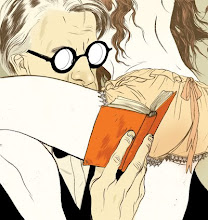This blog is, ostensibly, working in conjunction with the group over at www.bolanobolano.com , trudging our way through Roberto Bolano’s massive 2666. I decided, rather foolishly in retrospect, to read one of Bolano’s shorter works before I jumped headlong into an epic novel with no context and little understanding of his style. I found that reading Brief Interviews with Hideous Men prepared me for my sojourn through Infinite Jest; I hope that Nazi Lit. will prepare me for 2666. Of course, I’m already late with my first blog post—though some of that has to do with law school applications and the various things that come up. However, enough dilly-dallying! What about the book!?
Well, if Nazi Lit. is any indication, 2666 (especially from what I’ve read so far) is going to be hyper-literate. The book, which in the Borges fashion of writing reviews of books that don’t exist, serves as a brief encyclopedia of ultra-right-leaning or fascist-sympathizing writers that don’t exist. It’s a funny, at times upsetting little book which, as is wont to happen with postmodern writers, is more about writing and reading itself than about, well, anything else. It shares all of the hallmarks of this school of postmodern writing, alternating between harrowing and humorous. There is an even a Auster-esque turn at the end where Bolano becomes a character in his own story.
But the book’s real purpose takes awhile to tease out. As one reads the book, the characters sketched are rarely shown to be the monsters expected from the title. More than anything, they are sort of pathetic. Some, the less successful ones, are striving to be men and women of letters, their political opinions are really an afterthought and the writer’s who do show actual talent are rarely punished for their right-wing beliefs. The, one would assume, liberal critics and intelligentsia generally praise the stronger works of the Nazi writers. Either Bolano is attempting to implicate the liberal community allow with the fascists, or he is trying to legitimize good art, no matter its source.
I think the answer lies somewhere in the middle. Because of its splintered structure, it is easy to forget that Nazi Lit. should be read as a cohesive whole. The last story, “The Infamous Ramirez Hoffman,” is the one that ties the book together. Hoffman is a serial killer, pilot, and poet whose favorite medium is skywriting. At an exhibition put on by the Chilean government, Hoffman flies (while writing, of course) through increasingly turbulent weather as a handful of bystanders look on. Bolano writes that “[t]hey understood the pilot’s will and knew that although they couldn’t make head or tail of it, they were witnessing an event of great significance for the art of the future” (189). First of all, the quote begins with a contradiction. Two journalists watching understand the writer’s will but at the same time cannot make “heads or tails of it.” They simply have a gut feeling that they are witnessing the art of the future. It turns out it is the art of the very near future. After the performance, there is an exhibition at Hoffman’s apartment which, presumably, display’s grisly photos of his many victims. The future bit makes more sense when Hoffman’s skywritten poems are taken into context. Many of them deal with death explicitly stating that death is ‘friendship…Chile…responsibility…love…growth…communion…cleansing…my heart…resurrection” (188-9). In other words, Hoffman has made death his art. While the journalists can’t understand it, they still get it on a gut level. Bolano may be implicating everyone with that statement.
This is a bit of an oversimplification (as will be a theme in this blog), but Hoffman serves to put into stark contrast the other writers in this book. Here we have a look at pretty pure evil, which is generally how people view Nazis and their ilk. Perhaps Bolano is saying more about literature than he is about his reader[s conceptions, but through humanizing the lesser fascists, he is attempting to make us understand what drives someone to such extreme and unconscionable beliefs. It is important that Hoffman is the only true monster, because that means the rest are just human and, well, humanity is easier to deal with.
But, what does this have to do with 2666? If this book is any indication we will be in store for a funny, literate (and full of references to authors I’ve never heard of), frightening, and sad book. But a lot longer. With fewer Nazis.


No comments:
Post a Comment